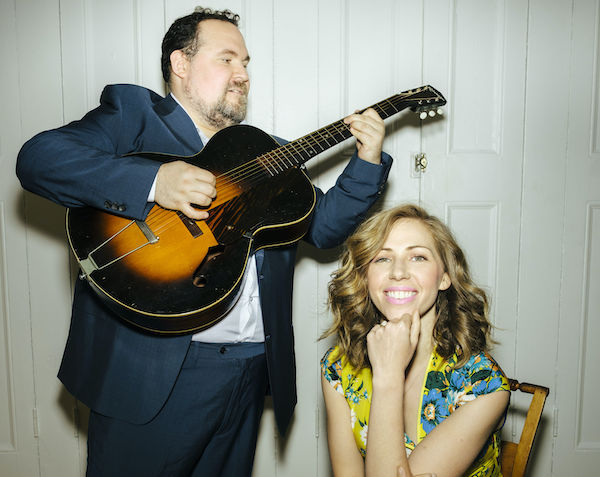Apr 2, 2024 12:59 PM
Saxophonist, Sonic Explorer Casey Benjamin Dies at 45
Casey Benjamin, the alto saxophonist, vocalist, keyboardist and producer who stamped his distinctive sounds on the…

Rachael Price (right) of the band Lake Street Dive teamed up with Vilray for a new duo album.
(Photo: Jonno Rattman)Artists compulsively find new ways of bridging past and present. On their debut album, Rachael & Vilray (Nonesuch), singer Rachael Price and guitarist, singer and composer Vilray proffer a way of connecting not-quite-the-past with not-quite-the-present, resulting in a timeless quality.
“We were trying to avoid sounding like a jazz album from today,” said Vilray, “but also trying to avoid sounding like a jazz record from the ’30s.”
Vilray, who composed the 10 original tunes on the 12-track recording, mined repertoire of the 1930s through the late ’50s for inspiration; despite its referencing different eras, he and Price aimed for cohesion. “It all feels like it’s part of the same record,” he said. “It’s got a vibe from top to bottom.” Rachael & Vilray includes an appearance from pianist Jon Batiste and horn-section arrangements from saxophonist/clarinetist Jacob Rex Zimmerman.
Price and Vilray, who met as students at New England Conservatory, achieved the sweet spot for their sound working with engineer Dan Knobler. He secured a tight room where the artists could play all together, recording only a couple takes per tune. From the outset, the duo rejected the notion of recording a “nostalgia album,” according to Price, who serves as lead vocalist for NEC-born rock band Lake Street Dive. “It also can’t sound super-modern, because that would be too jarring,” Vilray said. “It’s a fine balance.”
The artists themselves struck a balance that reflects give-and-take during the creative process, a departure from Price’s more open-ended process with Lake Street Dive. “This band is kind of a different thing,” she said. She cites an example of their push-pull dynamic on a tune Vilray had written with Fats Waller’s vocal in mind. Price chose to channel someone else’s.
“I wanted to be more like Doris Day because I don’t sing like Fats Waller,” she said. “That’s not somebody I would try to emulate.” In that way, Price feels she turned the creative challenge back on her partner, who received her interpretation and responded.
A more personal challenge for Price was embodying the essence of a singer’s individual contributions without imitating their sound. “I try to picture the energy that they were feeling when they were [recording] for the first time,” she said. “They were probably going into the studio and producing sounds that were new to them. So, it’s important to me to make sounds that feel new to me.”
Vilray’s desire to compose music that could serve singers from past eras compelled him to write new lyrics that referenced starched collars and the Lindy Hop. But as much as he might have sought to exclude lyrics that reflect the current era, he can’t escape his own experiences. Though not explicitly stated, a powerful topic pervades “Alone At Last,” one that hadn’t held much of a thematic spotlight during the ’30s: social anxiety.
While he asserts anxiety and panic disorders have existed long before they received an entry in the DSM, Vilray admitted few pre-war lyricists likely wrote about them the way he does. “That’s a very different song, in terms of the writing,” he said. “That was an ‘of my life’ love song. I wasn’t writing that for anybody else. Probably, the word ‘agoraphobic’ wasn’t on everybody’s lips [in a previous era], but I was still trying to think of it in terms of timelessness.”
For the duo, its not-quite-current, not-quite-vintage intention proved both challenging and truly rewarding. “I don’t think I was expecting people to like it that much,” Price said, laughing. “This is the music that I love. When we started doing it together, I really just envisioned it as something I was doing for myself, and I’d found a person who loved it as much as I did.” DB

Benjamin possessed a fluid, round sound on the alto saxophone, and he was often most recognizable by the layers of electronic effects that he put onto the instrument.
Apr 2, 2024 12:59 PM
Casey Benjamin, the alto saxophonist, vocalist, keyboardist and producer who stamped his distinctive sounds on the…

“He’s constructing intelligent musical sentences that connect seamlessly, which is the most important part of linear playing,” Charles McPherson said of alto saxophonist Sonny Red.
Feb 27, 2024 1:40 PM
“I might not have felt this way 30 to 40 years ago, but I’ve reached a point where I can hear value in what people…

Albert “Tootie” Heath (1935–2024) followed in the tradition of drummer Kenny Clarke, his idol.
Apr 5, 2024 10:28 AM
Albert “Tootie” Heath, a drummer of impeccable taste and time who was the youngest of three jazz-legend brothers…

“Both of us are quite grounded in the craft, the tradition and the harmonic sense,” Rosenwinkel said of his experience playing with Allen. “Yet I felt we shared something mystical as well.”
Mar 12, 2024 11:42 AM
“There are a few musicians you hear where, as somebody once said, the molecules in the room change. Geri was one of…

Henry Threadgill performs with Zooid at Big Ears in Knoxville, Tennessee.
Apr 9, 2024 11:30 AM
Big Ears, the annual four-day music celebration that first took place in 2009 in Knoxville, Tennessee, could well be…